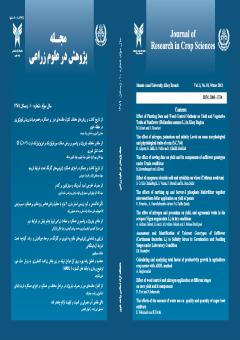اثر مصرف خارجی اسید آبسزیک و سیتوکینین بر گندم (Triticum aestivum)
محورهای موضوعی : توليد محصولات زراعي
1 - دانشگاه آزاد اسلامي، واحد كرج، دانش آموخته كارشناسي ارشد زراعت، كرج، ايران
کلید واژه: تنظيم كننده هاي رشد گياهي, ظهور سنبله, عملکرد دانه, گندم, منبع,
چکیده مقاله :
اسید آبسزیک (ABA) و سیتوکینین CK)) علاوه بر تنظیم فرآیند های مرتبط با پیری در شکل گیری قدرت منبع و مخزن نقش اساسی دارند. این تحقیق به منظور بررسی اثرات مصرف خارجی این دو تنظیم کننده رشد با غلظت 100 میکرو مولار در 9 سطح : 1 - شاهد- 2- Ck در زمان ظهور سنبله 3- Ck در 14 روز بعد از ظهور سنبله 4- ABA در زمان ظهور سنبله 5 - ABA در 14 روز بعد از ظهور سنبله - Ck در زمان ظهور سنبله و ABA در 14 روز بعد از ظهور سنبله 7- ABA در زمان ظهور سنبله و Ck در 14 روز بعد از ظهور سنبله 8- ABA در هر دو زمان 9 - Ckدر هر دو زمان، بر عملکرد، اجزای عملکرد گندم در مراحل رشد دانه در سال زراعی 88-1387 در مزرعه تحقیقاتی دانشگاه آزاد اسلامی واحد کرج در قالب طرح بلوک های کامل تصادفی در 3 تکرار اجرا گردید. نتایج حاصل از مصرف خارجی این دو هورمون در مراحل مختلف رشد زایشی( ظهور سنبله و14 روز بعد از ظهور سنبله) نشان داد که عملکرد دانه، شاخص برداشت و وزن هزار دانه به طور معنی داری تحت تاثیر مصرف خارجی این دو هورمون گرفتند. بیشترین عملکرد دانه به میزان 09/738 (گرم در متر مربع) مربوط به مصرف خارجی سیتوکینین در زمان ظهور سنبله بود. بیشترین شاخص برداشت و تعداد دانه در خوشه با مصرف خارجی سیتوکینین در هر دو زمان به دست آمد. بالاترین وزن هزار دانه مربوط به مصرف خارجی سیتوکینین در زمان ظهور سنبله و اسید آبسزیک در 14 روز بعد از ظهور سنبله مربوط می شود. نتایج حاصل از این تحقیق نشان داد که سیتوکینین از طریق تاثیر بر تقسیم سلولی و اسید آبسزیک از طریق تاثیر بر سرعت پر شدن دانه به طور معنی داری عملکرد دانه را افزایش می دهند.
CK and ABA not only regulate the process of senescence, but also have major roles in the formation of sink and source strength capacity. This study carried out to determine effect of exogenous application of ck and ABA(100Mm ) at the 9 levels : 1 - Control, 2 - CK at the time of appearance, 3 - CK 14 days after its spike emergence 4 - ABA at the time of appearance 5 - ABA 14 days after its spike emergence, 6 - CK at the time of appearance and ABA 14 days after its spike emergence, 7 - ABA at the time of appearance and CK 14 days after its spike emergence, 8 - ABA at the time of 1 and 14 days after its spike emergence, 9 - CK at the time of 1 and 14 days after its spike emergence , on some aspects in different steps of wheat growth in using a Randomized complete Block design(RCBD) with three replications in experimental field of Islamic Azad university of Karaj branch in growing season 1387- 88. Results showed that when these plant growth regulators applied at different stages of spike appearance and 14 days after its spike emergence , grain yield, harvest index (HI), 1000 grain weight, were meaning fully influenced by the exogenous application of the two regulators. The highest grain yield (738.09 gr/m2) one related to exogenous application of CK at the time of spike emergence . The highest hardest index and number grain spike is related to the exogenous application of CK at both time ( 1 and 2 ). the highest 1000 grain weight is related to the exogenous application of CK at the time of appearance and ABA 14 days after its spike emergence respectively. The results of the study showed that exogenous application of CK at cell division and ABA at grain filling on stage in grain growth phase may significantly improve grain yield.
Boonjung H. and S. Fukai. 1996. Effects of soil water deficit at different growth stages on rice growth and yield under upland conditions: Phenology, biomass production and yield. Field Crops Res 48: 47–55
Brenner M.L. and N. Cheikh. 1995. The role of hormones in photosynthate partitioning and seed filling. In: Davies P.J.(eds) , Plant Hormones. Kluwer Academic Publishers, the Nether- lands, pp.649-670.
Davis, T.D., and E.A. Curry. 1991. Chemical regulation of vegetative growth. Plant Sci. 10: 151-165.
Eradatmand-Asli, D. and I. S. Dua. 2008a. Cytokinins contents and dry matter accumulation at different position and types of grains within a spike of wheat. In: R. Appels, R. Eastwood, E. Lagudah, P. Langridge and M. Mackay Lynne(eds.). The Proceedings of the 11th International Wheat Genetics Symposium. Brisbame, Astralia. 45: 227-244.
Koch, K. 2004. Sucrose metabolism: regulatory mechanisms and pivotal roles in sugar sensing and plant development. Current Opinion. Plant Biol. 7: 235–246.
Lenoble, M. E., W. G. Spollen and R. E. Sharp. 2004. Maintenance of shoot growth by endogenous ABA: genetic assessment of the involvement of ethylene suppression. J. Exp. Bot. 55: 237-254.
Liang J.S., Cao X.Z. and Zhu Q.S. 1996. ABA may involve in the regulation of grain filling in water stressed rice. Chinese J.rice Sci. 10:29-36
Michael, G. and H. Seiler- Kelbitsch. 1972. Cytokining content and Kermel size of barely grain as affected by environmental and genetic factors. Crop Sci. 12:162-165.
Morris R.D., Blevins D.G., Dietrich J.T., Durly R.C.,Gelvin S.B., Gray J., Hommes N.G., Kaminek M., Mathews L.J., Meilan R., Reinbott T.M. and L. Sagavendra-Soto. 1993. Cytokinins in plant pathogenic bacteria and developing cereal grains. Aust. J. Plant Physiol. 20:621-637.
Nooden, L. D. 1988. Abscisic acid, auxin, and other regulators of senescence. In: Nooden L. and Leopold A.(eds) , Senescence and Aging in Plants. Academic Press, San Diego, pp. 329-368.
Peltonen J. and E. Nissila. 1996. Pre- and Postanthesis duration of two-rowed barleys in relation to stability of grain yield at high latitudes. Hereditas 124:217-222.
Pospisilova, J., M. Vagner, J. Malbeck, A. Travnickova and P. Batkova. 2005. Interactions between abscisic acid and cytokinin during water stress and subsequent rehydration. Biologia Planta. 49: 533-540.
Rajala, A., and P. Peltonen-Sainio. 2001. Plant growth regulator effects on spring cereal root and shoot growth. Agron. J. 93:936-943.
Roitsch, T. and R. Ehneb. 2000. Regulation of source/sink relations by Cytokinins. Plant Growth Regulators. 32: 359-367.
Saeidi, M., F. Moradi, A. Ahmadi, K. Poostini and G. Najafian. 2006. Effect of exogenous application of ABA and CK at different stages of grain development on some physiological aspects of source and sink relationship in two bread wheat cultivars. Iranian Journal of Crop Sciences. Vol. 8, No. 3, pp 268-282.(In Persian).
Smart, C. M. 1994. Gene expression during leaf senescence. Transley Review New Phytologist 126: 419-448.
Weber, H., U. Heim, S. Golombek, L. Borisjuk and U. Wobus. 1998. Assimilate uptake and the regulation of seed development.Seed Sci. Res. 8: 331-345.
Wingler, A., A. Scahewen, C. L. Richard, J. Peter and W.L. Paul-Quic.1998. Regulation of leaf senescence by cytokinin, sugars and light. Plant Physiol. 116: 329-335.
Xie, Z., D. Jiang, T. Dai and W. Cao. 2004. Effect of exogenous ABA and cytokinin on leaf photosynthesis protein accumulation in wheat ears cultured in vitro. Plant Growth Regul. 44: 25-32. water stress during grain gilling. Plant Physiol. 127: 315–32.
Yang J., Zhang J., Wang Z., Liu L. and Q. Zhu. 2003. Postanthesis water deficits enhance grain filling in two-line hybrid rice. Crop Science 43:2099-2108.
Yang, J., J. Zhang, Z. Wang and Q. Zhu. 2003. Hormones in the grains in relation to sink strength and development of spikelets in rice. Plant Growth Regulators. 41: 185-195.
Yang, J., J. Zhang, Z. Wang, Q. Zhu and L. Liu. 2002. Abscisic acid and Cytokinins in the root exudates and leaves and their relationship to senescence and remobilization of carbon reserves in rice subjected to water stress during grain filling. Planta. 215: 645-652.
Yang, J., J. Zhang, Z. Wang, Q. Zhu and W. Wang. 2001. Hormonal changes in the grains of rice subjected to water stress during grain gilling. Plant Physiol. 127: 315–323.
Zang, X. , T. Wang and C. Li. 2005. Different responses of two contrasting wheat genotypes to abscisic acid application. Biologia Planta. 49:613-616.

